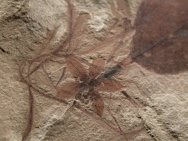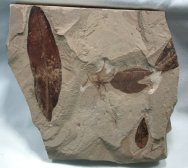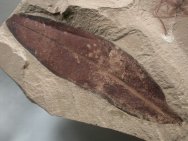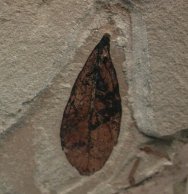 The
Green River Formation deposits of Wyoming, Colorado, and Utah are
best known for their immaculately-preserved fish, but other examples
are known as well, as this specimen attests. This fine flower is
known Astronium of the family Anacardiaceae whose extant members
include the cashew, mango, and smoke tree. The stamen is clearly
visible, and the flower has numerous comose (tuft like) seeds in
strong contrast to the matrix. The two smaller leaves belong to
members of the Leguminosae, or legumes, known as Eythrina raoanensis
and one that may be from the genus Leguminosites. While most legumes
are shrubs, members of the genus Erythrina are known as coral trees
by virtue of the rich color of their flowers. The largest leaf comes
from a member of the Araliaceae, or Aralias, known as Oreopanax.
The Araliaceae is also commonly termed the Ivy family. The
Green River Formation deposits of Wyoming, Colorado, and Utah are
best known for their immaculately-preserved fish, but other examples
are known as well, as this specimen attests. This fine flower is
known Astronium of the family Anacardiaceae whose extant members
include the cashew, mango, and smoke tree. The stamen is clearly
visible, and the flower has numerous comose (tuft like) seeds in
strong contrast to the matrix. The two smaller leaves belong to
members of the Leguminosae, or legumes, known as Eythrina raoanensis
and one that may be from the genus Leguminosites. While most legumes
are shrubs, members of the genus Erythrina are known as coral trees
by virtue of the rich color of their flowers. The largest leaf comes
from a member of the Araliaceae, or Aralias, known as Oreopanax.
The Araliaceae is also commonly termed the Ivy family.
|




